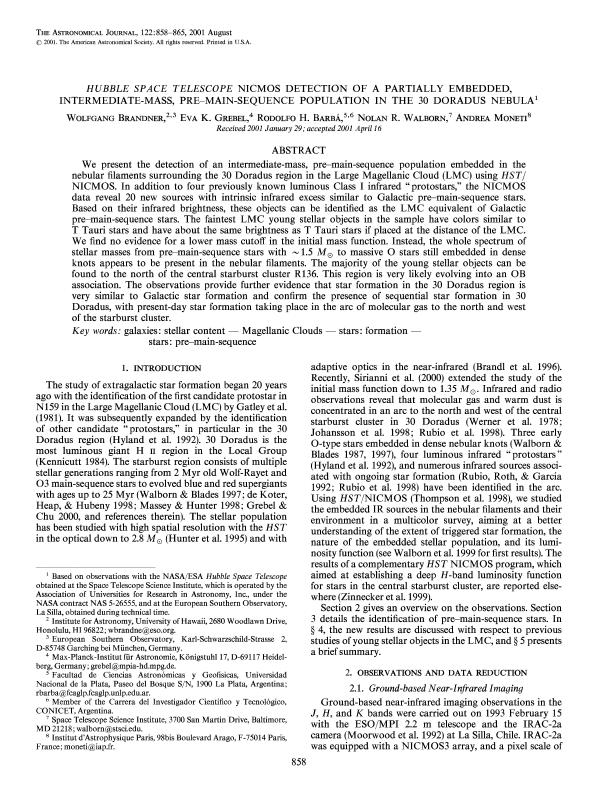Mostrar el registro sencillo del ítem
dc.contributor.author
Brandner, Wolfgang
dc.contributor.author
Grebel, Eva K.
dc.contributor.author
Barba, Rodolfo Héctor

dc.contributor.author
Walborn, Nolan Revere

dc.contributor.author
Moneti, Andrea
dc.date.available
2023-10-05T12:32:03Z
dc.date.issued
2001-12
dc.identifier.citation
Brandner, Wolfgang; Grebel, Eva K.; Barba, Rodolfo Héctor; Walborn, Nolan Revere; Moneti, Andrea; Hubble space telescope nicmos detection of a partially embedded, intermediate-mass, pre-main-sequence population in the 30 doradus nebula; IOP Publishing; Astronomical Journal; 122; 2; 12-2001; 858-865
dc.identifier.issn
0004-6256
dc.identifier.uri
http://hdl.handle.net/11336/214200
dc.description.abstract
We present the detection of an intermediate-mass, pre-main-sequence population embedded in the nebular filaments surrounding the 30 Doradus region in the Large Magellanic Cloud (LMC) using HST/ NICMOS. In addition to four previously known luminous Class I infrared "protostars," the NICMOS data reveal 20 new sources with intrinsic infrared excess similar to Galactic pre-main-sequence stars. Based on their infrared brightness, these objects can be identified as the LMC equivalent of Galactic pre-main-sequence stars. The faintest LMC young stellar objects in the sample have colors similar to T Tauri stars and have about the same brightness as T Tauri stars if placed at the distance of the LMC. We find no evidence for a lower mass cutoff in the initial mass function. Instead, the whole spectrum of stellar masses from pre-main-sequence stars with ∼1.5 M⊙ to massive O stars still embedded in dense knots appears to be present in the nebular filaments. The majority of the young stellar objects can be found to the north of the central starburst cluster R136. This region is very likely evolving into an OB association. The observations provide further evidence that star formation in the 30 Doradus region is very similar to Galactic star formation and confirm the presence of sequential star formation in 30 Doradus, with present-day star formation taking place in the arc of molecular gas to the north and west of the starburst cluster.
dc.format
application/pdf
dc.language.iso
eng
dc.publisher
IOP Publishing

dc.rights
info:eu-repo/semantics/openAccess
dc.rights.uri
https://creativecommons.org/licenses/by-nc-sa/2.5/ar/
dc.subject
GALAXIES: STELLAR CONTENT
dc.subject
MAGELLANIC CLOUDS
dc.subject
STARS: FORMATION
dc.subject
STARS: PRE-MAIN-SEQUENCE
dc.subject.classification
Astronomía

dc.subject.classification
Ciencias Físicas

dc.subject.classification
CIENCIAS NATURALES Y EXACTAS

dc.title
Hubble space telescope nicmos detection of a partially embedded, intermediate-mass, pre-main-sequence population in the 30 doradus nebula
dc.type
info:eu-repo/semantics/article
dc.type
info:ar-repo/semantics/artículo
dc.type
info:eu-repo/semantics/publishedVersion
dc.date.updated
2023-07-07T20:32:05Z
dc.journal.volume
122
dc.journal.number
2
dc.journal.pagination
858-865
dc.journal.pais
Reino Unido

dc.journal.ciudad
Londres
dc.description.fil
Fil: Brandner, Wolfgang. European Southern Observatory; Alemania. University of Hawaii at Manoa; Estados Unidos
dc.description.fil
Fil: Grebel, Eva K.. Max-Planck-Institut Astronomie; Alemania
dc.description.fil
Fil: Barba, Rodolfo Héctor. Consejo Nacional de Investigaciones Científicas y Técnicas. Centro Científico Tecnológico Conicet - San Juan. Instituto de Ciencias Astronómicas, de la Tierra y del Espacio. Universidad Nacional de San Juan. Instituto de Ciencias Astronómicas, de la Tierra y del Espacio; Argentina
dc.description.fil
Fil: Walborn, Nolan Revere. Space Telescope Science Institute; Estados Unidos
dc.description.fil
Fil: Moneti, Andrea. Institut D’astrophysique de Paris; Francia
dc.journal.title
Astronomical Journal

dc.relation.alternativeid
info:eu-repo/semantics/altIdentifier/url/https://iopscience.iop.org/article/10.1086/322065
dc.relation.alternativeid
info:eu-repo/semantics/altIdentifier/doi/http://dx.doi.org/10.1086/322065
Archivos asociados
